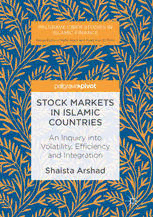
Stock Markets in Islamic Countries: An Inquiry into Volatility, Efficiency and Integration PDF
Preview Stock Markets in Islamic Countries: An Inquiry into Volatility, Efficiency and Integration
Palgrave CIBFR Studies in Islamic Finance Series Editors Nafis Alam University of Nottingham Malaysia Campus Selangor, Malaysia Syed Aun R. Rizvi Lahore University of Management Sciences Islamabad, Pakistan TheCentreforIslamicBusinessandFinanceResearch(CIBFR)isaglobal center of excellence for developing Islamic business and finance as a scientificacademicdisciplineandforpromotingIslamicfinancialproducts, monetaryandfiscalpolicies,andbusinessandtradepractices.BasedatThe UniversityofNottinghamcampusinMalaysia,CIBFRlooksatthemulti- dimensionalaspectsofIslamicbusiness,cuttingacrossthemajorthemesof Islamic economics, Islamic finance and the Halal market. True to the pioneering nature of the research CIBFR undertakes, the Palgrave CIBFR Series in IslamicFinance offers empirical enquiriesinto key issues andchallengesinmodernIslamicfinance.Itexploresissuesinsuchvaried fields as Islamic accounting, Takaful (Islamic insurance), Islamic financial servicesmarketing, andethical andsociallyresponsible investing. More information aboutthisseries at http://www.springer.com/series/15190 ShaistaArshad Stock Markets in Islamic Countries fi An Inquiry into Volatility, Ef ciency and Integration ShaistaArshad UniversityofNottinghamMalaysiaCampus Semenyih,Malaysia PalgraveCIBFRStudiesinIslamicFinance ISBN978-3-319-47802-9 ISBN978-3-319-47803-6(eBook) DOI10.1007/978-3-319-47803-6 LibraryofCongressControlNumber:2016957405 ©TheEditor(s)(ifapplicable)andTheAuthor(s)2017 This book was advertised with a copyright holder in the name of the publisher in error, whereastheauthorholdsthecopyright. This work is subject to copyright. All rights are solely and exclusively licensed by the Publisher,whetherthewholeorpartofthematerialisconcerned,specificallytherightsof translation, reprinting, reuse of illustrations, recitation, broadcasting, reproduction on microfilms or in any other physical way, and transmission or information storage and retrieval,electronicadaptation,computersoftware,orbysimilarordissimilarmethodology nowknownorhereafterdeveloped. Theuseofgeneraldescriptivenames,registerednames,trademarks,servicemarks,etc.inthis publicationdoesnotimply,evenintheabsenceofaspecificstatement,thatsuchnamesare exemptfromtherelevantprotectivelawsandregulationsandthereforefreeforgeneraluse. Thepublisher,theauthorsandtheeditorsaresafetoassumethattheadviceandinformation in this book are believed to be true and accurate at the date of publication. Neither the publishernortheauthorsortheeditorsgiveawarranty,expressorimplied,withrespectto thematerialcontainedhereinorforanyerrorsoromissionsthatmayhavebeenmade. Coverillustration:PatternadaptedfromanIndiancottonprintproducedinthe19thcentury Printedonacid-freepaper ThisPalgraveMacmillanimprintispublishedbySpringerNature TheregisteredcompanyisSpringerInternationalPublishingAG Theregisteredcompanyaddressis:Gewerbestrasse11,6330Cham,Switzerland To my parents. Thank youforeverything. C ONTENTS 1 Introduction 1 References 6 2 BackgroundonBusiness Cycles 7 2.1 Description ofBusiness Cycles 7 2.2 The Different Types ofCycles 9 2.3 Theories ofBusiness Cycles 9 2.3.1 RealBusiness CycleTheory 10 2.3.2 KeynesianTheory ofBusiness Cycles 11 2.3.3 Austrian BusinessCycle Theory 12 References 12 3 Overviewof the Organizationof Islamic Cooperation 15 3.1 Introduction 15 3.2 Salient Features of OICMember CountriesEconomy 17 3.2.1 Malaysia 18 3.2.2 Indonesia 18 3.2.3 Pakistan 19 3.2.4 Bangladesh 19 3.2.5 Turkey 20 3.2.6 Jordan 20 3.2.7 Egypt 21 3.2.8 Nigeria 21 3.2.9 Kuwait 21 vii viii CONTENTS 3.2.10 TheUAE 22 3.2.11 Qatar 22 3.2.12 Oman 22 3.3 OIC Member StatesStock Markets 22 References 28 4 Vettingthe Volatility 31 4.1 Introduction 31 4.2 Why StudyVolatility? 32 4.2.1 RelationshipBetween StockMarkets and Business Cycles 33 4.2.2 Withinthe OIC 34 4.3 Methodology 35 4.3.1 Formulating theBusiness Cycle 35 4.3.2 Decompositionof StockReturns 36 4.3.3 Volatility ofStocks 37 4.4 Data Used 37 4.5 Results and Discussions 39 4.5.1 Malaysia 44 4.5.2 Indonesia 45 4.5.3 Pakistan 47 4.5.4 Turkey 49 4.5.5 Jordan 51 4.5.6 Egypt 53 4.5.7 Kuwait 54 4.5.8 Nigeria 56 4.5.9 TheUAE 57 4.5.10 SaudiArabia 58 4.5.11 Qatar 59 4.6 Conclusion 60 References 61 5 Examiningthe Efficiency 63 5.1 Introduction 63 5.2 Importanceof Efficiency 64 5.3 Stock MarketEfficiency in theOIC 65 5.4 Theory Behind Efficient Markets 65 CONTENTS ix 5.5 Data and Methodology 68 5.5.1 TestingMarket Efficiency 68 5.6 Empirical Analysis 69 5.6.1 OverallEfficiency 70 5.6.2 Rankingof Marketsfor Major Periods 71 5.6.3 Efficiency Rankings ofIndividual Markets 74 5.7 Conclusion 83 Note 83 References 84 6 Investigatingthe Integration 85 6.1 Introduction 85 6.2 Why StudyMarketIntegration? 86 6.3 Market Integrationinthe OIC 87 6.4 Relationship BetweenBusiness Cyclesand Market Integration 88 6.5 Theory Behind MarketIntegration 89 6.6 Data Selection 90 6.7 Methodology 91 6.7.1 InternationalCapitalAssetPricingModel(ICAPM) 91 6.7.2 Multivariate GARCH 93 6.8 Analysis andResults 94 6.8.1 Country-wise Analysis 98 6.8.2 Regional Integration 106 6.9 Conclusion 116 Notes 116 References 116 7 Conclusion 119 Index 125 L F IST OF IGURES Fig.3.1 GrowthtrendofGDPofOICcountries 16 Fig.3.2 NetForeigndirectinvestmentflowtotheOIC (incurrentUS$) 17 Fig.3.3 Marketcapitalization/GDPforOICmembercountries 26 Fig.3.4 NumberoflisteddomesticcompaniesforOICmember countries 27 Fig.3.5 Valuetraded/marketcapitalizationforOICmember countries 28 Fig.4.1 MarketcapitalizationofOICmembercountriesin2014 39 Fig.4.2 Graphsofbusinesscyclesofsamplecountries 40 Fig.6.1 Businesscyclegraphsforeachsamplecountry 94 Fig.6.2 FMarketintegrationwithworldbenchmarkforsample countries 97 xi
